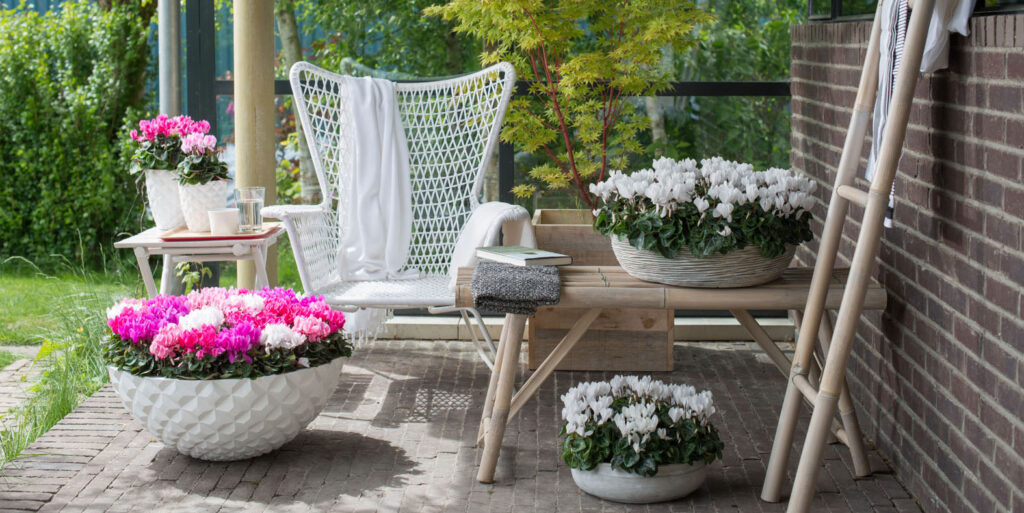Cyclamen are loved by flower lovers worldwide. Rightly so, because the heart-shaped green leaves, together with the colourful flowers, are a real eye-catcher in any interior. The garden or terrace also liven up with a Cyclamen nearby. Even all year round. And all thanks to innovative breeding and production by our suppliers. Time to put this versatile flower in the spotlight.
Love and joy
The Cyclamen has a long history. Originally from the region around the Mediterranean Sea, this bulbous plant symbolises love and joy. The name ‘Cyclamen’ comes from the Greek word ‘kyklos,’ meaning ‘circle,’ referring to the circular growth of the flowers. This array of butterfly-like flowers is what makes the plant so special. With their pink, purple-pink or white flowers, they bring colour all year round.
There are two versions of the plant: a tuberous plant that can be gardened as a hardy perennial. These are the Cyclamen coum also known as the Alpine violet. In this article, we highlight the second family, the non-hardy variety, namely the Cyclamen persicum.
Cyclamen all year round
Cyclamen are available almost year-round. To cover that period, growers need different bloodlines. As a result, there are many varieties in circulation with all kinds of own brands. The varieties are made specifically for a certain period of the year and the growing conditions that go with it. Certain varieties do well when grown in summer. In autumn, when there is less light, they will not do as well. Conversely, there are varieties that flourish in autumn but are too loose in summer and stretch the flowers too much.
Wide range thanks to our suppliers
Two major companies specialise in species and seed development. Morel is a family-owned company that has been innovating in Cyclamen breeding for more than a century. Morel creates, produces and sells the seeds of its F1 hybrids worldwide. The company breeds high-quality varieties with distinctive characteristics. Schoneveld Breeding has existed since 1930. We talk to them in detail later in this article.
The seed is raised by other companies that sell the young plants to growers. The best known here are: Beekenkamp, which has specialised in vegetable, pot and bedding plants, packs and chrysanthemums since 1951. Schneider Youngplants grows young plants from seeds and cuttings. The range includes annuals, biennials and perennials; pot plants and cut flowers. Vollebregt Cyclamen has specialised in the cultivation of Cyclamen since the 1970s.
To cover this full range, we naturally need several growers. Our two main ones are John Grootscholten and Kees Preesman.

Economic and ecological added value
Schoneveld Breeding is a specialist in innovative and responsible plant breeding of Cyclamen, among others. Their main development criteria? Sustainable cultivation of flowering pot plants that add value both ecologically and economically. In this way, they contribute to the future for generations to come with new, sustainable plant genetics.
In developing those genetics, they consider the following traits:
- Heat tolerance: to make Cyclamen more resilient in a warming climate.
- Cold tolerance in cultivation: to reduce energy costs for growers.
- Moisture tolerance: to better cope with too much or too little moisture.
- Outdoor durability: many consumers do not know that cyclamen are also suitable for the garden or terrace. Under the ‘best for outdoor’ label, the strongest varieties can be marketed.
- Less resource use: by focusing heavily on genetics that require less inhibitors.
- Special flower drawings or colours.
By focusing strictly on the above characteristics in the breeding process, we get a genetically strong product that keeps for a long time and flowers uniformly. A plant distinguished by compact, round plant structure with many flowers on sturdy stems. By the way, did you know that every leaf is a potential flower? So Cyclamen with lots of leaves, automatically produce lots of flowers.
Cyclamen: something for everyone
Cyclamen can be divided into groups according to flower size:
- Micro: for very small pot sizes (6-9)
- Mini: for small pot sizes (9-11)
- Midi: for the most common pot size in cyclamen (11-12)
- Large: for larger pot sizes (12-15)
- Extra large: for the largest pot sizes (15-19)
Within each pot size, there are Cyclamen in different colours. And the cultivation period can also differ. Variety rules, then.
To illustrate the range at grower Schoneveld:
- Micro/Mini Cyclamen: Verano (summer), Carino (autumn), Mini winter
- Midi Cyclamen: Allure (spring), Elegante (late summer/autumn) and Macro (winter).
- Large Cyclamen: (Leopardo (summer), Mammoth NextGen (autumn), Vintro (winter)

This is how Cyclamen stay beautiful for longer
Indoor care tips
Cyclamen brighten up any interior. And last even longer with these tips.
- Put them in a bright spot in the house, so not above the heating or in direct sunlight. A north- or east-facing window is ideal.
- Cyclamen like cool temperatures. Between 10°C and 18°C is perfect.
- Cyclamen are sturdy drinkers. Keep the root ball moist but not too wet. Tip: put the plant on a saucer with water. On average, the Cyclamen will want to drink about three times a week. Also let the plant drain well after watering. Is the Cyclamen looking a bit limp? Time to water it.
- Regularly pick spent flowers including stems to encourage the plant to produce new flowers.
- Add some plant food to the water every fortnight. This will keep the plant beautiful, fresh and flowering for a long time.
Outdoor care tips
Did you know that Cyclamen can also thrive outdoors? With these tips, they will bring even more colour and atmosphere to your garden or terrace.
- Choose Cyclamen that are suitable for outdoor use and carry a Best for Outdoor label. These varieties can best withstand elements like sun and rain. Even a light night frost will tolerate them.
- Do not put the Cyclamen in full sun.
- Make sure the root ball is and stays moist.
- Outdoor cyclamen also benefit from a little plant food every 3 weeks.
- Remove the spent flowers including the stalk.
